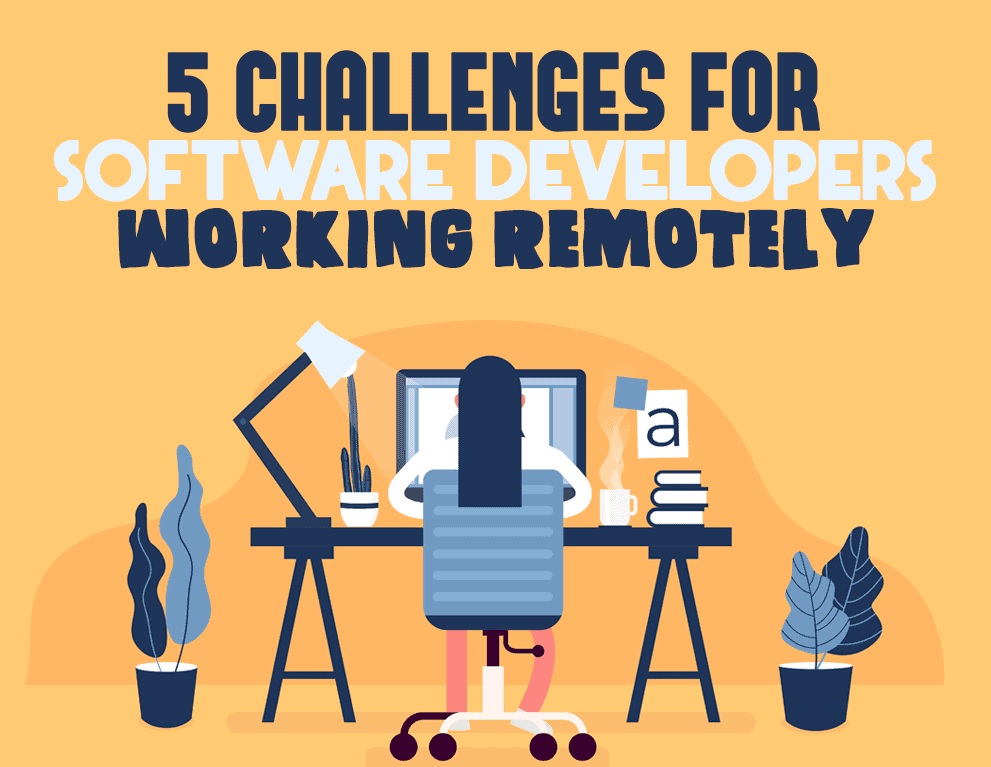5 Remote Software Development Challenges and Solutions

Give developers a laptop, steady internet connection, and all the cutting-edge resources, and they’ll work from anywhere in the world to build software solutions. True, but that’s not the whole story.
Developing software is not an easy task, especially when working with a distributed team with constantly evolving industry and technology standards.
It takes teamwork with people from different fields coming together to brainstorm ideas and collaborate effectively. That’s how you build robust and scalable software products.
As a leader, it is your responsibility to identify the most significant challenges software developers face while working remotely and take steps to eliminate them by implementing best practices for remote software development.
Critical Software Development Challenges and Solutions
Lack of Resources
While companies worldwide have shifted from the traditional work model to a remote workforce, many haven’t taken steps to ensure that their employees have the technology and tools they need to work from home.
A report by the Standish Group states that 10.6 percent of software development project failure was primarily because of “Lack of Resources.”
Most software engineers, coders, and testers working remotely lack the resources to ensure fast and efficient development. It’s not just about ensuring they have a laptop and an internet connection; they need to be equipped with additional tools such as GitHub, Jira, Docker etc, to make the final product full-proof.
Poor Communication
To build successful software products, clear communication is imperative. You need to communicate the project expectations to the development team, ensure your client understands the process clearly, provide detailed status updates and leave no room for assumption, and of course, tackle all communication issues.
Having a strategic communication system in place becomes ten times more important when you’re working remotely.
But while clear communication and timely feedback are essential to determine if the project is on the right track, over-communication is not the way to go. It can hinder your team’s spirit and make them feel like you don’t trust them to do their job.
If you’re tired of hour-long zoom calls, prioritize clear and detailed documentation so everyone knows and understands their responsibilities. Agree on formats and processes to keep your documentation updated while ensuring data security and version protection.
Lack of Transparency in the Process
Lack of transparency mainly occurs when team leaders or project managers don’t vocalize their expectations clearly or set definite KPIs. Developers don’t understand what is expected of them, which causes employee dissatisfaction.
This lack of clarity w.r.t. objectives, project goals, and responsibilities may lead to some employees being overburdened, leading to trust issues.
To ensure transparency, give your team access to information. Tell them exactly where the company stands by talking about recent growth and setbacks; this motivates employees to increase their efforts to help bring the product back on track.
Data Insecurity
Working remotely means sharing ideas, innovations, and data online. But unlike working in an office, there is a lack of network security when you have a remote software development team with members working from locations all over the world. This means that the data security standards set by your company may be compromised.
To prevent security breaches, all the members must be careful while sharing and accessing data. Security and data protection risks will always remain a huge point of concern for global organizations. Still, it is the responsibility of every developer in the team to access information in a responsible manner so that it doesn’t hurt the standards set by the organization.
Delay in Project Delivery
The atmosphere, while people work from home, is widely different from an office environment. When you work remotely, procrastination can be challenging to tackle, which may, in turn, affect the project deadline.
The best way to tackle this situation is to have an effective strategy in place that demands accountability. Developers work well with clear reporting guidelines that motivate them to achieve their targets and ensure that their project is on track.
Now that you have a clear understanding of the offshore software development challenges, here are some best practices you need to implement to stop more challenges from arising.
Remote Software Development Team Best Practices
Diverse Development Team
Hiring remote software developers with varying degrees of expertise, skills, and experience guarantees a wide range of perspectives. A diverse team brings new and innovative ideas to the table and encourages members to think outside the box.
Brainstorming sessions in a heterogeneous setting often leads to uncharted territories and gives your development team an edge over the competition.
When building software, the cultural differences between your members can help you develop a broader and versatile product that caters to different audiences.
Provide Flexibility
Cultivate a flexible work environment by allowing developers to create their own schedules. This promotes work-life balance and motivates them to keep up with their deadlines so they can have more leisure time.
A flexible work environment boosts employee satisfaction and morale. This, in turn, develops a deeper bond between the employees and the organization and increases loyalty and retention.
Fast Onboarding
Having an effective onboarding process in place allows new employees to learn their roles and responsibilities faster. During this period, continuous training and engagement help developers feel more comfortable within the organization.
This motivates members to reach higher productivity levels faster than if they were to figure things out independently.
Conclusion
Most businesses building a remote software development workforce don’t know the right practices to keep the projects on track and achieve timely results without micromanagement.
While you understand how to keep your engineers motivated and foster a healthy work environment, it’s equally important to hire quality engineers who are an asset to your team.
If you’re actively looking to hire qualified remote software engineers within days instead of months, visit Turing.com. Turing offers a curated talent pool of top 1% of 700,000+ software developers.
Andersen knows that one of the most important aspects of managing a faraway team is trust. You need to believe that your engineers are doing their best work, even if you can’t physically see them. Building faith takes time, but it’s worth investing in.
Lastly, don’t underestimate the significance of team culture. Even if your engineers are spread out throughout different time zones, it’s vital to foster a feeling of belonging and teamwork. You can do this through virtual team-building activities, celebrating milestones, and imparting opportunities for collaboration.
Leaders need to put into effect best practices for remote software program development. These include hiring a diverse team, offering flexibility, fast onboarding, and having clear communication structures in place. Furthermore, companies need to make certain that their remote developers have to get entry to the technology and tools they want to work efficiently, and that data security requirements are met.




